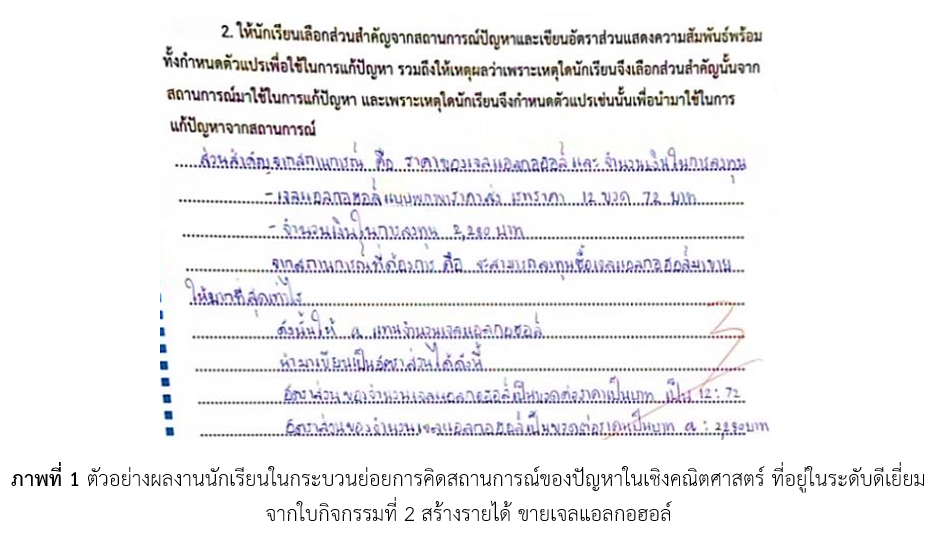การพัฒนาความฉลาดรู้ด้านคณิตศาสตร์ด้วยการจัดการเรียนรู้โดยใช้ ตัวแบบเชิงคณิตศาสตร์ เรื่อง อัตราส่วน สำหรับนักเรียนชั้นมัธยมศึกษาปีที่ 1
Main Article Content
บทคัดย่อ
การวิจัยครั้งนี้มีวัตถุประสงค์เพื่อพัฒนาความฉลาดรู้ด้านคณิตศาสตร์ด้วยจัดการเรียนรู้โดยใช้ตัวแบบเชิงคณิตศาสตร์เรื่อง อัตราส่วน สำหรับนักเรียนชั้นมัธยมศึกษาปีที่ 1 ผู้เข้าร่วมการวิจัย คือ นักเรียนชั้นมัธยมศึกษาปีที่ 1 จำนวน 44 คน ของโรงเรียนมัธยมศึกษาแห่งหนึ่งในจังหวัดพิจิตร ในภาคเรียนที่ 2 ปีการศึกษา 2564 ผู้วิจัยใช้รูปแบบการวิจัยปฏิบัติการใน ชั้นเรียน จำนวน 3 วงจร โดยใช้ระยะเวลาทั้งหมด 9 ชั่วโมง เครื่องมือที่ใช้ในการวิจัย ได้แก่ แผนการจัดการเรียนรู้โดยใช้ ตัวแบบเชิงคณิตศาสตร์ เรื่อง อัตราส่วน จำนวน 3 แผน ใบกิจกรรม และแบบทดสอบวัดความฉลาดรู้ด้านคณิตศาสตร์ วิเคราะห์ข้อมูลโดยใช้การวิเคราะห์เชิงเนื้อหา ผลการวิจัยพบว่า นักเรียนส่วนใหญ่มีระดับความฉลาดรู้ด้านคณิตศาสตร์อยู่ในระดับดีเยี่ยม เมื่อพิจารณาตามกระบวนการทั้ง 3 กระบวนการ พบว่า นักเรียนส่วนใหญ่สามารถพัฒนาการคิดสถานการณ์ของปัญหาในเชิงคณิตศาสตร์ได้ดีที่สุด รองลงมา คือ การใช้หลักการ ข้อเท็จจริง กระบวนการและเหตุผลทางคณิตศาสตร์ในการแก้ปัญหา และกระบวนการที่พัฒนาน้อยที่สุด คือ การตีความประยุกต์ใช้และประเมินผลลัพธ์ทางคณิตศาสตร์ กล่าวได้ว่า การจัดการเรียนรู้โดยใช้ตัวแบบเชิงคณิตศาสตร์ช่วยพัฒนาความฉลาดรู้ด้านคณิตศาสตร์ได้ โดยนักเรียนได้เรียนรู้จากการวิเคราะห์สถานการณ์ปัญหาที่ใกล้เคียงกับชีวิตจริงของนักเรียน การสร้างตัวแบบเชิงคณิตศาสตร์ และเชื่อมโยงสิ่งที่ได้เรียนรู้ สู่สถานการณ์อื่น ๆ จนสามารถระบุประเด็นปัญหา ใช้หลักการและกระบวนการทางคณิตศาสตร์ที่เหมาะสมและสอดคล้องกับสถานการณ์ปัญหา และสามารถอธิบายความสมเหตุสมผลของผลลัพธ์ได้
Article Details

อนุญาตภายใต้เงื่อนไข Creative Commons Attribution-NonCommercial-NoDerivatives 4.0 International License.
วารสารวิทยาศาสตร์และวิทยาศาสตร์ศึกษา (JSSE) เป็นผู้ถือลิสิทธิ์บทความทุกบทความที่เผยแพร่ใน JSSE นี้ ทั้งนี้ ผู้เขียนจะต้องส่งแบบโอนลิขสิทธิ์บทความฉบับที่มีรายมือชื่อของผู้เขียนหลักหรือผู้ที่ได้รับมอบอำนาจแทนผู้เขียนทุกนให้กับ JSSE ก่อนที่บทความจะมีการเผยแพร่ผ่านเว็บไซต์ของวารสาร
แบบโอนลิขสิทธิ์บทความ (Copyright Transfer Form)
ทางวารสาร JSSE ได้กำหนดให้มีการกรอกแบบโอนลิขสิทธิ์บทความให้ครบถ้วนและส่งมายังกองบรรณาธิการในข้อมูลเสริม (supplementary data) พร้อมกับนิพนธ์ต้นฉบับ (manuscript) ที่ส่งมาขอรับการตีพิมพ์ ทั้งนี้ ผู้เขียนหลัก (corresponding authors) หรือผู้รับมอบอำนาจ (ในฐานะตัวแทนของผู้เขียนทุกคน) สามารถดำเนินการโอนลิขสิทธิ์บทความแทนผู้เขียนทั้งหมดได้ ซึ่งสามารถอัพโหลดไฟล์บทความต้นฉบับ (Manuscript) และไฟล์แบบโอนลิขสิทธิ์บทความ (Copyright Transfer Form) ในเมนู “Upload Submission” ดังนี้
1. อัพโหลดไฟล์บทความต้นฉบับ (Manuscript) ในเมนูย่อย Article Component > Article Text
2. อัพโหลดไฟล์แบบโอนลิขสิทธิ์บทความ (Copyright Transfer Form) ในเมนูย่อย Article Component > Other
ดาวน์โหลด ไฟล์แบบโอนลิขสิทธิ์บทความ (Copyright Transfer Form)
เอกสารอ้างอิง
Consortium for Mathematics and Its Applications (COMAP) and Society for Industrial and Applied Mathematics (SIAM). (2016). Guidelines for Assessment and Instruction in Mathematical Modeling Education. Bedford: Consortium for Mathematics and Its Applications.
Dickinson, P., Eade, F., Gough, S. and Hough, S. (2010). Using realistic mathematics education with low to middle attaining pupils in secondary schools. Proceedings of the British Congress for Mathematics Education (pp. 73-80). Manchester: University of Manchester.
Kanthawat, C. (2018). An action research on developing grade 11 students’ mathematical literacy through mathematical modeling in topic of sequences and series (in thai). Master’s Thesis. Phitsanulok: Naresuan University.
Kammis, A. and Mc Taggart, R. (2000). The Action Research Planer (3rd ed). Victoria: Dekin University.
Ministry of Education. (2015). The basic education core curriculum 2551 (in thai). BangKok: The Agricultural Co-operative Federation of Thailand.
Pluempitiwiriyawej, K. (2016). Development of an instructional process based on mathematical modeling and scaffolding approaches to enhance mathematical problem solving and representation abilities of lower secondary school students (in thai). Journal of Education Studies, 47(4), 86-107.
Srithi, K., Supap, W. and Wiriyapong, R. (2018). An action research on developing problem-based learning activities to enhance mathematical literacy in conic section topic of students in grade 10 (in thai). Social Sciences Research and Academic Journal, 13(37), 105-118.
The Institute for the Promotion of Teaching Science and Technology (IPST). (2020). Mathematical literacy (in thai). Retrieved 25 August 2020, From PISA Thailand: https://pisathailand.ipst.ac.th/about-pisa/mathematical-literacy/.
The Institute for the Promotion of Teaching Science and Technology (IPST). (2020). Mathematical literacy about PISA (in thai). Retrieved 1 September 2020, From PISA Thailand: https://pisathailand.ipst.ac.th/.


